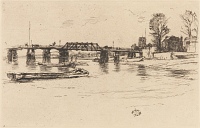Etchings Institutions search term: grolier club
Chelsea | ||
| Number: | 181 | |
| Date: | 1878/1879 | |
| Medium: | etching and drypoint | |
| Size: | 133 x 207 mm | |
| Signed: | butterfly at lower right | |
| Inscribed: | no | |
| Set/Publication: | Printseller's Association, 1879. | |
| No. of States: | 5 | |
| Known impressions: | 66 | |
| Catalogues: | K.182; M.179; W.148 | |
| Impressions taken from this plate (66) | ||
KEYWORD
barge, bridge, building, church, people, pier, river, sailors, tree.
TITLE
The original title was radically changed, as follows:
'Chelsea' (1879, F.A.S.). 2
Possibly 'Battersea Bridge' (1879, The Athenaeum). 3
'Chelsea' (1882, The Art Journal). 4
'Fulham' (1886, Frederick Wedmore (1844-1921)). 5
'Fulham' (1909, Howard Mansfield (1849-1938)). 6
The etchings shows Chelsea Church and old Battersea Bridge, and the original title, 'Chelsea', is preferable.
'Chelsea' (1879, F.A.S.). 2
Possibly 'Battersea Bridge' (1879, The Athenaeum). 3
'Chelsea' (1882, The Art Journal). 4
'Fulham' (1886, Frederick Wedmore (1844-1921)). 5
'Fulham' (1909, Howard Mansfield (1849-1938)). 6
The etchings shows Chelsea Church and old Battersea Bridge, and the original title, 'Chelsea', is preferable.
2: Publication, January 1879.
3: 14 June 1879, p. 769.
4: May 1882, f.p. 129.
5: Wedmore 1886 A (cat. no. 148).
6: Mansfield 1909 (cat. no. 179).
The view does show 'Battersea Bridge' but as a title this could be confused with other etchings of the bridge such as Old Battersea Bridge
[188], and in any case it is not certain that the title as recorded by The Athenaeum actually refers to this etching.
Fulham and Chelsea are adjacent districts north of the river Thames. The etching may have been called 'Fulham' by Wedmore and subsequent cataloguers to distinguish it from other etchings of Battersea Bridge and Chelsea. However, it does not show Fulham.
The changes have led to confusion and problems in identifying the subsequent history of this etching.
DESCRIPTION
Three barges are seen in the middle of the River Thames, the one nearest the bridge manned by two bargees. Behind them is an old bridge, with four wooden piers seen to left, a broad iron span, and then three more piers to right. There are figures, horses and carts on the bridge. Seen through the arches are a steamboat landing-stage, more trees and houses on an embankment on the right, and a suspension-bridge. The tide is low, so that the two right-hand piers are out of the water, and a couple of flat-bottomed barges sit high on the beach to right. To the right, a square church tower rises behind the bridge, the toll-booth is just visible at the end of the bridge, and a substantial square house and other buildings stand at far right, surrounded by tall trees.
SITE
The view shows Battersea Bridge and old Chelsea church. Chelsea lies north of the river Thames, in London. It was drawn on the plate on site and, as usual, reversed in the print.
This is one of a series of etchings of bridges across the River Thames, including Old Putney Bridge
[185],
Little Putney Bridge
[186], and
Old Battersea Bridge
[188]. Putney Bridge, upstream, to west, is followed by Wandsworth, Battersea, the Albert Bridge (which is the suspension bridge seen through the arches), and then the Chelsea, Vauxhall, Lambeth, Westminster, Hungerford, Waterloo, Blackfriars, Southwark and London Bridges.
DISCUSSION
This etching was definitely drawn with London clients in mind, carefully promoted and intended for sale to help Whistler's declining fortunes before and during the turmoil of his bankruptcy.
